Introduction
According to the PwC Future of Customer Experience report, one out of three customers will stop interacting with a brand they love after one bad experience.
To provide better digital experiences, marketers need to create relevant and targeted customer journeys.
Salesforce Marketing Cloud Engagement can help build and optimize such customer journeys through its various components.
What Is Salesforce Marketing Cloud Engagement?
Salesforce Marketing Cloud Engagement is a marketing automation platform utilized for creating and managing marketing relationships and campaigns with customers. The Marketing Cloud incorporates integrated solutions for customer journey management, email, mobile, social media, web personalization, advertising, content management, and data analysis.
It offers two types of modules that help build extensive customer experience journeys.
- Studios: Studios help organizations collect and analyze customer data from multiple channels. This data provides crucial insights into customer behavior, preferences, and demographics.
- Builders: Builders utilize the collected data to create customized journeys. It also helps optimize customer journeys based on engagement metrics.
Components For Building Customer Journeys In Salesforce Marketing Cloud
Salesforce Marketing Cloud offers a comprehensive suite of tools for building and optimizing customer journeys.
Journey Builder
Salesforce Marketing Cloud's Journey Builder has a user-friendly interface that enables organizations to build tailored customer journeys. Organizations can seamlessly craft the complete customer journey, spanning from initial engagement to final interaction.
Email Studio
With Email Studio, brands can design, send, and track personalized email campaigns, ensuring that messages are relevant throughout the customer journey.
Data Studio
Data Studio consolidates, manages, and analyzes customer data, providing comprehensive insights for optimized marketing strategies. Data Studio analytics reveal valuable insights into customer behavior and preferences.
Advertising Studio
Advertising Studio integrates with various advertising platforms to deliver targeted ads to specific audience segments. It helps optimize ad spending and maximizes ROI throughout the customer journey. On an average, businesses that use Salesforce Marketing Cloud tools have a 25% increase in revenue and a 30% increase in lead conversions.
Analytics
Salesforce Marketing Cloud offers robust reporting and analytics tools to track crucial metrics such as click-through rates, open rates, conversions, and ROI. Marketers can leverage these insights to optimize marketing strategies, improve audience engagement, and drive better outcomes.
How Salesforce Marketing Cloud Boosted Hmlet's Lead-to-Sales Conversion Rate by 28%
Hmlet, now acquired by Habyt, is the world's largest co-living company. The organization wanted to generate and maintain a steady flow of new leads. To achieve this goal, Hmlet utilized Salesforce Marketing Cloud to build customer journeys, engage prospects, and deliver a personalized experience.
Hmlet used Journey Builder to build customer journeys and nurture new leads to drive them down the sales funnel. The goal of this journey was to convert MQLs into SQLs. Every step was engineered based on behavioral data to drive engagement and conversions.
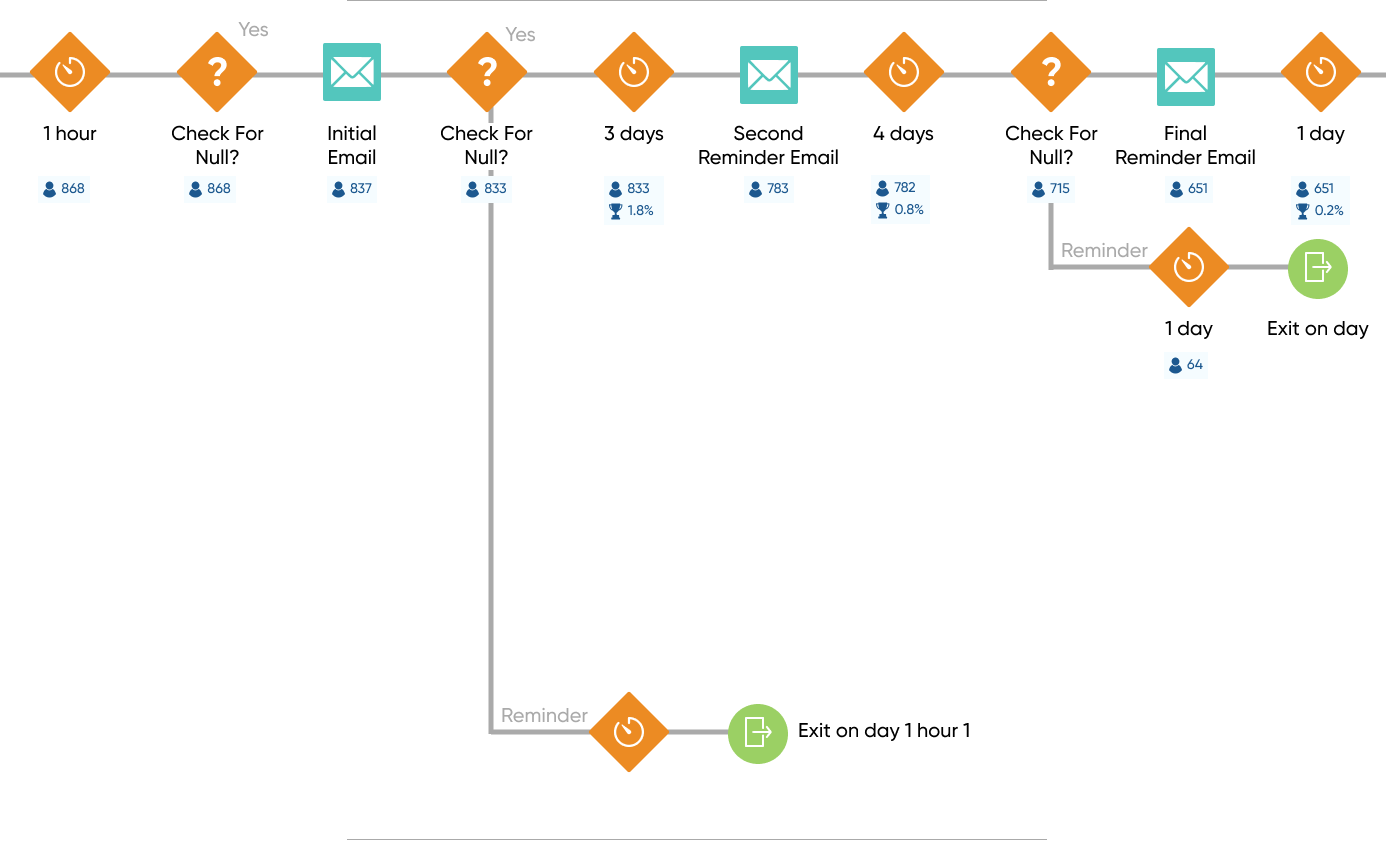
The journey begins with the prospect showing interest in Hmlet's services using the chatbot. These prospects receive an email thanking them for their interest with a ‘secure booking’ call-to-action.
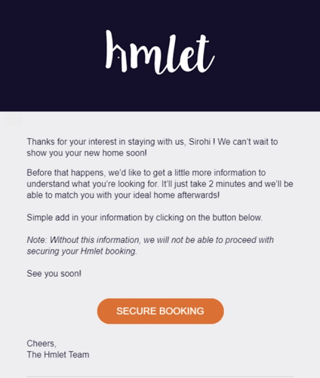
As the prospects click on the CTA, they are redirected to a landing page to share their basic information along with critical details like move-in date, duration of stay, and budget. Hmlet used this information to contact leads and launch personalized campaigns.
Using the Email Studio, a reminder email was sent to those who did not take action within 3 days after receiving the first email. A final reminder email was sent after 4 days to those who still hadn’t taken the desired action.
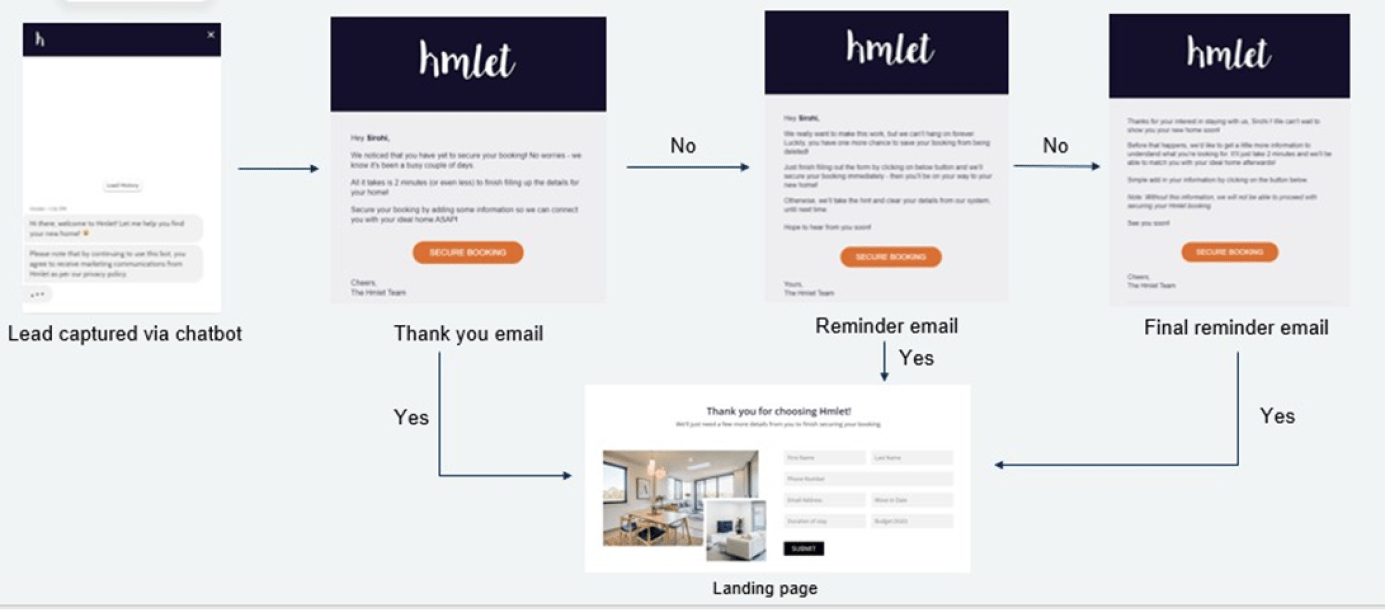
Hmlet automated the journey according to the customer’s desired move-in date. An automated email to schedule a call with the community managers was sent 15 days before the proposed move-in date.
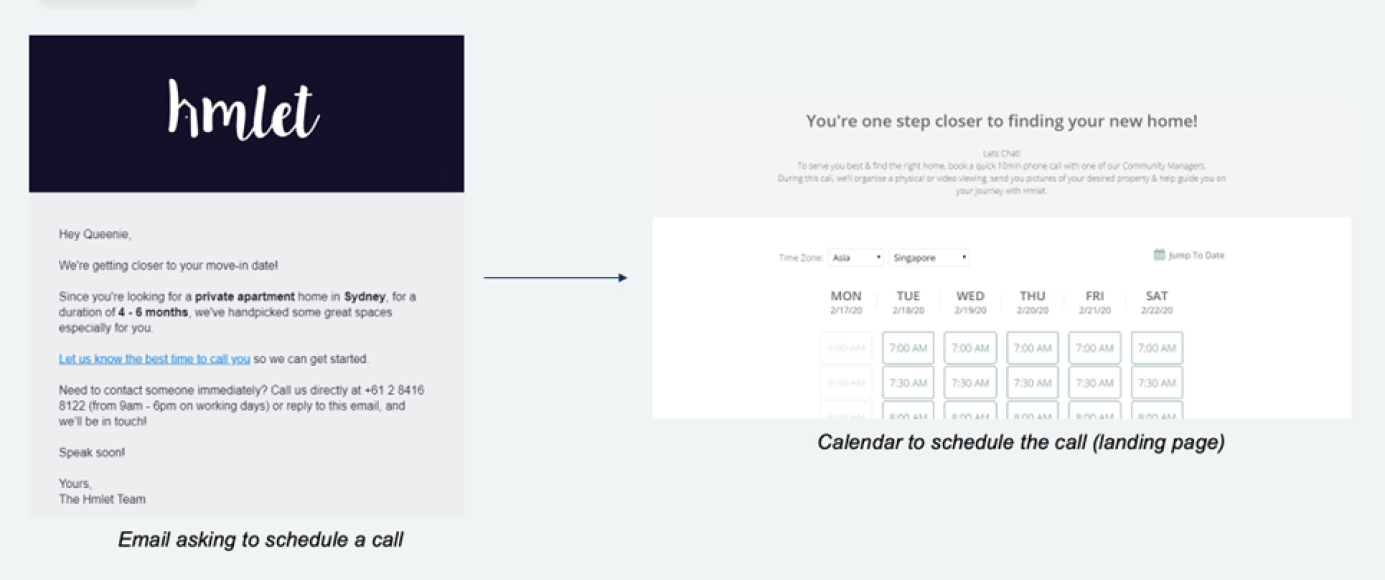
Throughout the customer journey, Hmlet used analytics to track and optimize the performance of the customer journeys.
By utilizing these strategies, Hmlet increased their MQL-to-SQL conversion by 67% and lead-to-sales conversion by 28%.
Steps For Creating Optimized Customer Journeys
There are seven steps organizations can follow to create personalized customer journeys.
Step 1: Identify Target Customer Personas
Define the target audience segments or personas based on demographic, psychographic, and behavioral characteristics. Understand their needs, pain points, motivations, and preferences to tailor the journey map accordingly.
Panasonic Life Solutions, a global electronics giant, identified target customer personas and ran targeted marketing campaigns to boost its sales productivity by 22%. The organization streamlined and automated its entire B2B sales lifecycle across six business units. Panasonic Life Solutions also optimized opportunity management, conversions, negotiations, and order management.
Step 2: Define The Customer Journey Stages
Outline the key stages or touchpoints that customers typically go through when interacting with the brand. These stages can include awareness, consideration, purchase, post-purchase, and advocacy.
%201-1.webp?width=1385&height=790&name=svgexport-1%20(3)%201-1.webp)
Customize the stages to comply with specific business models and customer journeys. Lyca Mobile, one of the largest telecom service providers, increased its conversion rates to over 30% by studying the customer interaction stages and implementing relevant campaigns.
With SFMC, the team at Lyca Mobile has a unified view of customer journeys across all touchpoints. This helps them deliver seamless omnichannel experiences. Lyca Mobile also uses Marketing Cloud to segment its audiences based on shared attributes. This makes customer communication more contextual and relevant.
Step 3: List Touchpoints
To identify various touchpoints, analyze both online and offline interactions with the customers across various stages.
- Awareness: Initial touchpoints can include social media ads, online search results, or word-of-mouth referrals.
- Consideration: Customers can visit the website, sign up for newsletters, or explore product/service reviews.
- Decision: Interactions might involve visiting a physical store for further product evaluation or contacting customer service for inquiries.
- Purchase: Touchpoints may include completing the transaction online or in-store, receiving confirmation emails, and post-purchase follow-ups.
- Post-Purchase: Follow-up communications such as feedback requests, loyalty program updates, or customer support interactions to complete the journey.
%202.webp?width=1385&height=790&name=svgexport-1%20(3)%202.webp)
Step 4: Identify Pain Points And Opportunities
Find out the pain points and opportunities for optimizing the customer journey. Identify moments of delight or satisfaction that can be utilized to boost the overall customer experience.
Walmart GoLocal retailers struggled to scale their business beyond a certain point. By utilizing Salesforce Marketing Cloud, these retailers identified challenges like:
- Lack of real-time order visibility
- Unreliable local pickup
- Fickle local delivery options
These challenges were caused primarily due to data silos. Using the Commerce Cloud, Walmart GoLocal shared access to a centralized repository of customer data and business opportunities with local vendors. This helped streamline efforts and improve business outcomes.
Step 5: Create Content
Creating content begins with understanding customer needs through detailed research and content mapping. The goal is to ensure a strategic alignment between content and journey stages.
Several content formats, such as videos, blog posts, and webinars, can be developed to cater to diverse preferences and consumption habits.
While creating content, organizations should follow clear brand guidelines to maintain consistency in messaging. Follow a content calendar and cross-channel content distribution to ensure a cohesive brand identity and user experience across all touchpoints.
Step 6: Choose Channels
Start by understanding customer preferences through data analysis. Identify preferred channels like email, SMS, social media, and mobile apps. Align these channels with specific journey stages, ensuring relevance and effectiveness at each step.
For example, organizations can use email for awareness and consideration stages while leveraging SMS for immediate and transactional communications.
CEAT, a multinational tyre manufacturing company, selected relevant channels while building their customer journey. This led to a 220% boost in its lead conversion rates. CEAT uses a Customer 360 dashboard for their sales teams. This data also guides the creation of customer journeys to include channels with the highest engagement.
Step 7: Analyze Data For Optimization
Collect data from various sources, integrate it into a centralized platform, deepen data insights with Pivot Tables and use analytics for tracking customer behavior and engagement. By monitoring key metrics, businesses can identify areas for improvement and implement iterative changes to enhance the overall experience.
While collecting user engagement data, businesses must comply with user privacy regulations to maintain customer trust.
L’Oréal, the world’s largest cosmetics and beauty company, uses Salesforce Marketing Cloud Analytics to track the performance of all its 28 sister brands. The goal of the organization is to ensure coordinated operations and engagement with millions of global customers.
L’Oréal consolidates their sales efforts and backend systems. This helps the Professional Products Division to share data and coordinate brands, resulting in a jump in operational efficiencies.
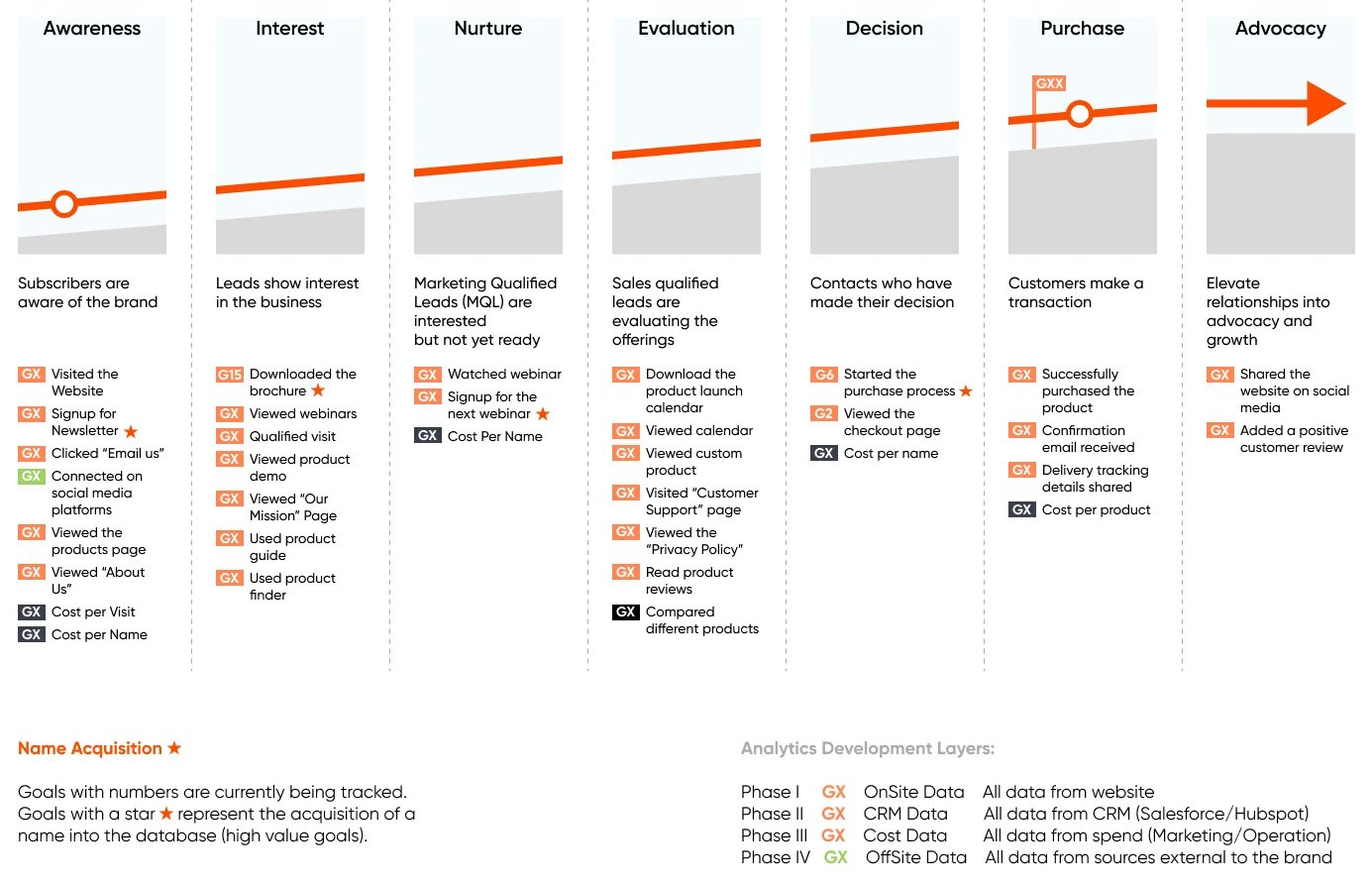
How Ottobock Is Utilizing Customer Journeys To Personalize User Experiences
Ottobock, a world leader in wearable bionics, operates in 60+ countries and 360+ patient care centers. Ottobock suffered from departmental silos that hindered the digital transformation required for maintaining their brand identity.
As a part of their Digital Experience Platform, Ottobock harnessed the power of data to fuel all interactions with customers. They built customer journeys mapped to treatment plans in Marketing Cloud to automate communications with prospective and existing product users.
After every purchase, a refitting customer journey is also triggered. Product users are sent reminders before the warranty expires or when their prosthetic or orthotic is due to be refitted or replaced.
As a result, Ottobock has seen an increase in their revenue, leads, and brand value.
Our experts at Axelerant can help build a similar solution that leverages customer journeys to personalize user experience. Schedule a call to learn how.

Abhishek Tripathi, DXP Consultant
Abhi likes to contribute to society, learns new skills from Trailhead, and when away from his desk, he spends quality time with his kids and helps out his wife and mother. When engaged, challenged, and appreciated at work, he’s unstoppable.
%20copy.png)
Sayan Mallick, Marketing Assistant
A former professional e-sports player, passionate about anime and technology—that’s Sayan. He is an eccentric explorer who likes to read, play games, teach, and spend time with his pet dog, Buddy.

Simran Sethi, Marketing Associate
Simran is an avid reader. She is an active runner, who also likes to swim, dance, and sing. For her, the meaning of life lies in the little things. Kindness, passion, and compassion are her life’s essential values.

 We respect your privacy. Your information is safe.
We respect your privacy. Your information is safe.



Leave us a comment